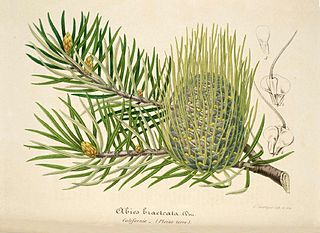
Abies bracteata, the Santa Lucia fir or bristlecone fir, is the rarest and most endemic fir in North America, and according to some, the world. It is confined to steep-sided slopes and the bottoms of rocky canyons in the Santa Lucia Mountains, in the Big Sur region on the central coast of California, United States.
David Don was a Scottish botanist.

Corydalis is a genus of about 470 species of annual and perennial herbaceous plants in the family Papaveraceae, native to the temperate Northern Hemisphere and the high mountains of tropical eastern Africa. They are most diverse in China and the Himalayas, with at least 357 species in China.

Iris bracteata, with common name is Siskiyou iris, is a species of iris.
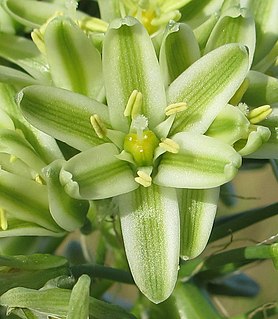
Albuca bracteata, is known by the common names pregnant onion, false sea onion, and sea-onion. It is a species of bulbous flowering plant in the family Asparagaceae. Its flowering stems can reach a height of 90 cm and can carry up to 100 greenish white flowers.

Amphicarpaea bracteata is an annual to perennial vine in the legume family, native to woodland, thickets, and moist slopes in eastern North America.
Liatris bracteata, commonly known as the bracted blazing star, or South Texas gayfeather, is a species of flowering plant in the aster family, Asteraceae. It is native to Texas in the United States, where it is found in coastal prairies, roadsides, and along railroads with clay or sandy loam soils. This species is of conservation concern in its native range due to habitat loss.

Disa bracteata, also known as South African weed orchid is a species of orchid native to South Africa.

Artocarpeae is a tribe within the plant family Moraceae. It includes 7 to 12 genera and 70 to 87 species including Artocarpus altilis, the breadfruit.
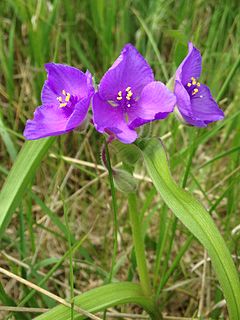
Tradescantia bracteata, the longbract spiderwort, or prairie spiderwort, is a species of Tradescantia. It is native to the northern and central Great Plains and Mississippi Valley regions of the United States, from Arkansas and Oklahoma north to Minnesota and Montana, with a few isolated populations farther east. It is grown for its purple flowers. It blooms from May to July in the US.

Verbena bracteata is a species of verbena known by the common names bracted vervain, bigbract verbena, prostrate vervain, and carpet vervain. It is native to North America where it is widespread, occurring throughout the continent except for northern Canada and southern Mexico. It occurs in many types of habitat, especially disturbed areas. It typically blooms between the months of May and October. This annual or biennial herb produces several hairy, spreading stems up to 30 centimeters long forming a low mat on the ground. The hairy leaves are toothed or lobed. The inflorescence is a spike of flowers which is dense with long, pointed, leaflike bracts each up to 8 millimeters long. Each small tubular flower is about half a centimeter wide and white to pale purple in color.

Veltheimia bracteata is a species of plant. It belongs to the genus Veltheimia, which contains only one other species, Velthemia capensis. Veltheimia bracteata is commonly referred to as the forest lily, sand onion, or red hot poker. This pendent shaped plant ranges in color from a yellowish pink to red. It is a winter flowering perennial plant, so is in full bloom when other flowers have withered away. Plants grow to be 12–18 inches (30–46 cm) in height.
Mucuna bracteata is a leguminous plant. It is a nitrogen-regulating plant that is used in agroecosystems operating around certain types of agricultural plant systems including: rubber trees, oil palm, citrus and coconut. M. bracteate is a cover crop which helps to cover and shield the soil from weeds or plants, as well as providing rapid growth for existing agricultural crops, preventing soil erosion, and providing nitrogen fixation. The Mucuna bracteata crop grows about 10–15 cm/day in conditions similar to those that rubber and palm oil plants thrive in.
Scleria bracteata, the bracted nutrush, is a plant in the family Cyperaceae. It grows as a perennial climber.

Melaleuca bracteata, commonly known as the black tea-tree, river tea-tree or mock olive is a plant in the myrtle family, Myrtaceae and is endemic to northern Australia. It usually occurs as a large shrub but under ideal conditions can grow into a tree up to 10 m (30 ft) tall. It is an adaptable species in cultivation and a number of cultivars have been developed.
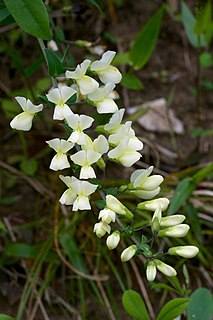
Baptisia bracteata, otherwise known as longbract wild indigo, long-bract wild indigo, long-bracted wild indigo, or cream false indigo, is a perennial herbaceous plant that is native to the central and eastern United States. It is one of the earliest blooming species of Baptisia, beginning to bloom in March in certain areas of the United States. The bloom color ranges from white to creamy yellow. The flower clusters (racemes) spread out sideways or sprawl across the ground, unlike most other Baptisia species, which have vertical racemes. The flowers are visited by bumblebees. The caterpillars of several skippers eat the leaves, including the wild indigo duskywing and hoary edge. The plant is poisonous to mammalian herbivores.
Coralliophila bracteata is an extinct species of sea snail, a marine gastropod mollusk, in the family Muricidae, the murex snails or rock snails.
Parartocarpus is a genus of trees in the family Moraceae. It is dioecious, with male and female flowers borne on separate plants.
Parartocarpus venenosa is a tree species in the family Moraceae.
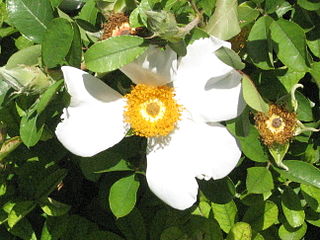
Rosa bracteata, commonly known as the Macartney rose, is a species of rose that is native to southern China and Taiwan, but is also present as an invasive in the US.












